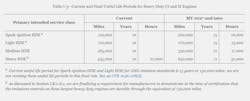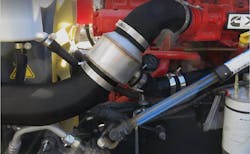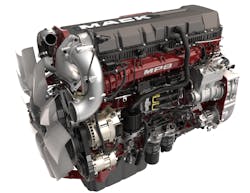In January, the U.S. Environmental Protection Agency entered the final new rule for model year 2027 and later heavy-duty engines in the Federal Register, solidifying stricter NOx emission standards and extended useful engine life cycle targets for engine manufacturers to hit.
For instance, the new standards call for heavy-duty commercial vehicles to limit NOx emissions to 0.035 grams per horsepower-hour during normal operation, 0.050 grams at low load, and 10 grams at idle. This is the first increase in NOx emissions standards since 2010 when aftertreatment systems became ubiquitous.
“There’s no question the rules will be a challenge for manufacturers to meet, but in ways different than previous emissions milestones,” said Allen Schaeffer, executive director of the Diesel Technology Forum, a non-profit advocacy group. “Technically the required NOx emissions reductions are significant, to the tune of 82% lower than today’s levels—which are already near zero (0.20 g/BHP-hr.)."
The EPA has also drastically increased the definition of what a heavy-duty engine’s useful life period should be, which Schaeffer is more concerned about.
“The more significant impact of the rules are the business side of the useful life and warranty requirements, which have jumped from 435,000 miles to more than 800,000 miles for an OTR tractor,” he explained. “This means that all parts of these emission control systems must be able to function for much longer periods of time than today, and manufacturers will be on the hook warranty wise at some level for how well the units perform not just in years 3 and 4, but in years 7 and 8, assuming about 100K miles a year. So there is a significant business/economic aspect to this rule that is new for manufacturers, and will certainly drive up the cost of a new truck.”
Another challenge is that OEMs not only have to improve on diesel engines, but concurrently develop battery-electric and fuel cell electric vehicles to comply with zero-emission guidelines in California and several other states.
“That makes balancing those investments with the next round of emissions standards development and compliance particularly challenging from a business perspective,” Schaeffer noted.
On the postive side, he noted, the first and second owners would benefit by having more warranty coverage pertaining to some of parts of these engines.
But the big question is if engine manufacturers can find a way to eke out even more emissions control than they have already?
“I think they can get there mostly with improvements to the technologies we have today, such as new SCR configurations and combustion enhancements,” Schaeffer asserted.
The good news is OEMs’ engineers have already spent a lot of time figuring out how to meet these more stringent emissions standards and will continue developing new technology and designs over the next few years.
Cummins, North America’s leading engine maker, has already been researching and testing some promising new innovations, which should be ready in time for 2027 rules, according to Matthew Spears, executive director for global regulatory affairs at Cummins.
“You can definitely expect to see new engine hardware and new aftertreatment hardware,” he said last fall at the American Trucking Associations’ Management Conference and Exhibition. “There are a number of technology paths that could or should be available to comply.”
One of these may be Catalyzed Diesel Exhaust Fluid technology, or CAT-DEF, a catalyst- and surfactant-modified diesel exhaust fluid solution developed by the Southwest Research Institute. Spears explained this technology uses a modified Cummins X15 engine that employs a different valve train to allow for cylinder deactivation, along with a second aftertreatment system on the upstream selective catalytic reduction (SCR), located between the turbocharger outlet and diesel particulate filter.
According to Dr. Charles E. Roberts Jr., director of the Commercial Vehicle Systems Department at the Southwest Research Institute, “A combination of surface-active agents and heterogenous catalysts blended into CAT-DEF reduces deposits by 90% with potential reductions up to 98%.”
Spears noted hardware changes like this will increase DEF consumption, but not by a significant amount.
New regulations aside, engine makers have also worked to continuously improve their on-highway diesel engines to stay ahead of the competition. And if those weren’t enough, engine makers have responded to the call for decarbonized solutions by delving more into advanced fuels, including propane, natural gas, and even hydrogen.
In short, there will be several new engine options coming in the next few years, and fleets will first have to figure out which fit best for their application and region. And then maintenance departments, dealers, and independent shops will have to find ways to support these engine types.
There’s a lot to keep up on, so Fleet Maintenance asked the manufacturers themselves how they plan to cross that emissions finish line in four short years.
OEM progress
Cummins
Last year was a bold one for Cummins, with the leading engine maker acquiring Meritor, a leader in making brakes, axle, and other components.
“We continue to see enhanced integration with different elements of the powertrain, including through our transmission joint venture, Eaton Cummins, and with axles through our acquisition of Meritor,” said Katie Zarich, director of on-highway communications at Cummins.
She agreed with Spears that the new standards are obtainable.
“The EPA 2027 Low-NOx Final Rule provides clarity and allows Cummins to refine its product plan and concentrate our resources on delivering those solutions,” said Zarich. “The next generation of medium- and heavy-duty fuel agnostic engine platforms will meet those regulations.”
Zarich also noted that field tests help the company learn more about how engines and powertrains perform in the real world and help fleets evaluate new features and developments.
Daimler Truck North America
The latest advancements in the Detroit heavy-duty lineup are the Gen 5 updates to DD15 and DD13 engines, reported Len Copeland, product marketing manager. “More than 50% of the parts of the engines are included in the update,” he said. “Updates that improve fuel economy for the DD15 had ripple effects as well because to enable them we increased the compression ratio to 21:1 and that required strengthening the block, the head, and many other internal parts.
“Another large area of focus with the Gen 5 update were new features that improve aftertreatment performance,” Copeland continued. “One of those was the introduction of Thermocoasting. When the vehicle begins to coast during a regen event, it engages by fueling three cylinders and applying engine braking on the other three. That adds zero torque to the flywheel but keeps the aftertreatment system very hot, resulting in less time to complete a regen event and a more complete regeneration.”
Mack Trucks
At Mack, Andrea Brown, director of product management–complete powertrain, pointed to a holistic approach to drivetrain integration for optimum performance and lower operating costs. For example, the manufacturer recently made Mack Predictive Cruise Control with Econo-Roll standard for on-highway models.
The solution combines the mDRIVE automated manual transmission with GPS and monitoring of speed, engine load, and road topography when cruise control is set. The next time a truck is on the same route, it automatically knows the optimal speed and gear strategy for the upcoming terrain, improving fuel efficiency.
Navistar
Navistar recently introduced the International S13 Integrated Powertrain.
“It’s much more than the engine,” said Chet Ciesielski, VP of Navistar’s on-highway heavy-Duty truck business. “Each component of the integrated powertrain was developed concurrently to ensure compatibility and that resulted in up to a 15% fuel efficiency improvement, a reduction in CO2 emissions, and a weight reduction.”
The S13 is designed with SCR as its primary emissions reduction technology. Without an EGR cooler that means 100% of the exhaust flows to the turbocharger in normal engine operating conditions, Ciesielski explained. That allows for a fixed geometry turbocharger and dual stage aftertreatment that deliver improved emissions control because with the EGR cooler eliminated, less soot and particulate matter are generated.
Paccar
Paccar, which makes the MX-11 and MX-13 engines for its Peterbilt and Kenworth brand trucks, did not offer many details on the future, but Carl Hergart, director of strategy and planning for Paccar Powertrain, did say: “Paccar Powertrain is positioned to meet the global emissions and fuel economy requirements over the coming decades. Alongside our significant efforts to develop a full lineup of electric powertrains, we will continue to invest and provide a product offering of clean diesel internal combustion powertrains for our customers for years to come.”
Volvo
Volvo’s latest advancement is I-Torque, a blend of powertrain components including the OEM’s D13 Turbo Compounding engine, 13-speed transmission, map-based I-See software, and ratios ranging from 2.15 to 2.17. The engines are designed with downspeeding to deliver higher torque and horsepower at lower rpm, noted Duane Tegels, product marketing manager, powertrain, Volvo Trucks North America.
For the powertrain, Volvo paired the 13-speed I-Shift with the D13 Turbo Compounding engine’s torque curve and faster rear axle ratios to allow the drivetrain to use the top three gears at road speed for the most efficient application. Top gear is used when traversing rolling hills while direct drive delivers greater power and efficiency on steeper grades, and underdrive uses torque multiplication to gain more pulling power, Tegels explained.
That approach allows the transmission to control the engine’s available horsepower for both grade and speed. To assist the transmission, I-See’s map-based software defines topography before a truck ascends or descends over terrain, allowing the drivetrain to disengage from the engine during descent in cruise, increasing its efficiency. It also downshifts before climbing a hill to manage momentum for a more efficient ascent.
Help from the fleets
While some manufacturers are not ready to comment on future engine products, improving the total cost of ownership by bringing efficient designs to market is a common goal. Overall, they all noted that developing solutions that meet new emissions standards will be a key focus.
“The next generation of diesel engine development will continue to reduce GHG emissions, which will support the industry and our own sustainability goals over the next decade,” Ciesielski said.
DTNA partners with fleets each time it develops new engine technology and provides them with units ahead of production to trial in their everyday operations, Copeland related. “These partnerships help us validate products and gain feedback while fleets get a preview of the engines prior to large order changes,” he said. “That allows for confidence-building in the engine changes as well as technician prep and parts support readiness for new products.”
“Connecting with the customers and verifying products in multiple duty cycles and environments is essential,” Tegels explained. “Volvo places engineering prototypes in fleets to verify satisfaction, fuel efficiency, performance, and overall durability.”
Mack is also in constant contact with customers through field sales and service experts to communicate their needs back to engineering teams, Brown noted. “We use this information to help direct product decisions,” she said.
“Working with fleets on new technologies enables a robust and proven product at time of launch,” Ciesielski said. “Many of our fleet customers are at the forefront of pushing for advanced technologies to help drive down total cost of ownership through better fuel economy, greater reliability, and longer lifecycles. They work closely with us to evaluate new products through pilot runs over many miles and help refine the designs.”
Still, there are challenges for fleets and manufacturers to overcome as they learn about and adopt new engine technologies.
For example, fleets who plan out vehicle lifecycles and maintenance requirements are challenged about how to ensure equipment purchasing decisions and in-house training requirements align with the pace of change for new technologies, Ciesielski pointed out.
“New technologies always have some level of hesitation and are adopted by some fleets faster than others,” Tegels said. “It’s a big decision to change from something that is working to the unknown because that can affect different areas within a fleet’s operation. Typically, new technologies come with new components, requiring technician training on service procedures, and there’s the need to stock new parts and consider how a driver interacts with the truck.”
Additionally, Zarich noted, resale value is important to customers. “And there is a learning curve with respect to maintenance intervals and serviceability,” she said. “We are doing a lot of work to help communicate what this means for our customers.”
For Copeland, the biggest challenge that OEMs and fleets share is how to improve engines the most while impacting fleets the least. “This balance is one that we work on constantly from the outset of engine development by bringing the customer into the process, often years in advance of product releases,” he said. “Many years ago, the biggest issue with releasing new engine technologies was receiving real-time feedback and determining the root cause when there were failures. Today, we’ve put those issues behind us.”
Additional reporting by Josh Fisher and John Hitch.
About the Author

Seth Skydel
Seth Skydel, a veteran industry editor, has more than 36 years of experience in fleet management, trucking, and transportation and logistics publications. Today, in editorial and marketing roles, he writes about fleet, service, and transportation management, vehicle and information technology, and industry trends and issues.






